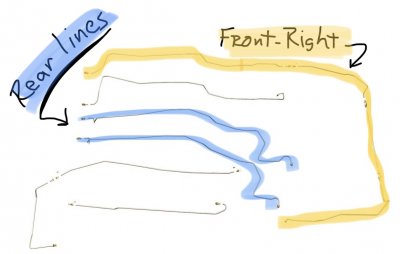yargnits
Full Access Member
- Joined
- Jan 27, 2010
- Posts
- 236
- Reaction score
- 36
Lucky me, I just replaced the 2 rear brake lines on my 04 Yukon. Yeah, 2 lines because of the active traction control. Can’t say it was fun.
I started with the left side using the vacuum method of solo bleeding. I kept getting air bubbles which could have come from a loose connection or...? I ended up enlisting my neighbor to use the pump and hold method. It appeared to work and I moved to the right side.
Note, using the pump/hold (pressure) method lets you know if you have a leak, and let’s you know where it’s at.
A broke bleeder nipple on the right rear lead to a new caliper. I went straight to the pump/hold method but the bleeding didn’t go as expected. After a couple rounds of good pump/hold sessions, the fluid barely came out when opening the bleeder and the pedal didn’t go to the floor. I then tried with the engine running and got one good pump/hold round before it went back to almost nothing coming out when the bleeder opened.
Could this be the antilock system?
I said a prayer and took it out for a test drive. After driving my car for most of the summer I can’t remember how the Yukon’s pedal felt. Any ideas on ways to test the rear brakes?
I do plan on trying to bleed them again, now that it’s been driven around a bit. I’ll eventually get one of the pressure bleeding systems.
I started with the left side using the vacuum method of solo bleeding. I kept getting air bubbles which could have come from a loose connection or...? I ended up enlisting my neighbor to use the pump and hold method. It appeared to work and I moved to the right side.
Note, using the pump/hold (pressure) method lets you know if you have a leak, and let’s you know where it’s at.
A broke bleeder nipple on the right rear lead to a new caliper. I went straight to the pump/hold method but the bleeding didn’t go as expected. After a couple rounds of good pump/hold sessions, the fluid barely came out when opening the bleeder and the pedal didn’t go to the floor. I then tried with the engine running and got one good pump/hold round before it went back to almost nothing coming out when the bleeder opened.
Could this be the antilock system?
I said a prayer and took it out for a test drive. After driving my car for most of the summer I can’t remember how the Yukon’s pedal felt. Any ideas on ways to test the rear brakes?
I do plan on trying to bleed them again, now that it’s been driven around a bit. I’ll eventually get one of the pressure bleeding systems.

